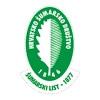
DIGITALNA ARHIVA ŠUMARSKOG LISTA
prilagođeno pretraživanje po punom tekstu
| ŠUMARSKI LIST 1-2/2007 str. 36 <-- 36 --> PDF |
D. Majnarić: ODSTRJEL I OTPAD SMEĐEG MEDVJEDA U GORSKOM KOTARU Šumarski list br. 1–2, CXXXI (2007), 25-34 Grupa autora, 2004: Plan gospodarenja smeđim med-Majnarić, D., 2002: Gospodarenje medvjedom kao vjedom u Republici Hrvatskoj. Ministarstvo po-zadatak državnog šumarstva. Šumarski list ljoprivrede, šumarstva i vodnog gospodarstva, 11–12: 601–611. Uprava za lovstvo,Ministarstvo kulture, Uprava Majnarić, D., 2005: Značaj gospodarenja smeđim za zaštitu prirode. Zagreb, 84 str. medvjedom (Ursus arctos L.) u Gorskom kotaru H ub e r, Đ., J. Ku s a k i A. F r k ov i ć , 1998: Traffic za stabilnost i strukturu populacije. Magistarski kills of brown bears in Gorski kotar, Croatia. rad na Šumarskom fakultetu. Zagreb, 116 str. Ursus 10: 167–171. Servheen, C., S. Herrero i B. Peyton, 1999: Huber, Đ., A. Frković i J. Kusak, 2002: Plan go-Bears-Status survey and conservation action spodarenja medvjedom na području priobalja Pri-plan. IUCN/SSC, Bear and polar bear specialist morsko-goranske županije. Primorsko-goranska groups, IUCN, Gland, Switzerland and Cam županija. Rijeka, 42 str. bridge, United Kingdom. K u s ak , J. i Đ. H ub e r, 1998: Brown bear habitat qua-S t a n k o vi ć, J., B. Ku l i ć , A. F r kovi ć, J. Tr o h a r, lity in Gorski kotar, Croatia. Ursus 10:281-291. A. F u ć a k , V. K ost i j a l , 1999: Vodić kroz lovi- Mclaughlin, C. R. i H. L. Smith, 1990: Baiting šta (Primorsko-goranske županije). Rijeka,174 str. black bears: hunting techniques and management issues. Eastern Workshop on Black Bear Re search and Management 10: 110–119. SUMMARY: The analysis of the brown bear bag and mortality was conducted for the period 1997/98 to 2002/03. The brown bear has been managed and harvested in all the hunting grounds of Gorski Kotar since 1997. The amount of 116 animals were harvested in the observed period, 51 animals were affected by mortality, while the total bag included 167 animals. The surface area of the hunting ground, or the management area where harvest is allowed, is 133,569 ha, and the total investigation area is 144,250 ha including Risnjak National Park and non-hunting grounds. The average annual bag for the period 1997/98 to 2002/03 was 27.84 animals; there were 18.17 males and 9.67 females. The average bag/1000 ha was 0.21 animals. Of this number, males accounted for 0.14/1000 ha and females for 0.07/1000 ha. The gender ratio was 63:33 in favour of the males. The average brown bear bag/1000 ha was 0.14 animals. Of this, there were 0.11 males/1000 ha and 0.03 females/1000 ha. Since the gender ratio was 76:24 in favour of the males, it is clear that the male bag was significantly higher than the female bag in the observed period. The average brown bear mortality/1000 ha was 0.07 animals with 0.03 males/1000 ha and 0.04 females /1000 ha. The gender ratio was 59:41 in favour of the females, indicating that the female participation in mortality was significantly higher than the male. A total of 71 % of the planned bag was accomplished. The bag trend from 1997/98 to 2002/23 indicates that the average bag rose by 3 animals per annum. Of this, the average harvest increased by 2.4 animals per year and the average mortality by 0.6 animals per year. The average annual bag from 1997/98 to 2002/23 in Gorski Kotar was 10.3 % of the average annual parent stock, which is significantly less that the average annual population increase, which is 25 % minimally of the average annual parent stock. Since the bag to date has been less than the population increase, the management capacity and the brown bear population growth was achieved. To conclude, hunting management did not endanger the survival of the brown bear in the area of Gorski Kotar. Bear hunt is carried out from high seats exclusively (100 % of the cases) and professional guides are used: therefore, such a hunt has more advantages than disadvantages. vantag Key words: the brow browbrown bear n |